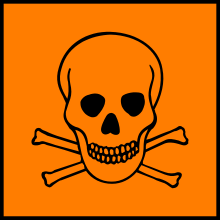Toxicity class

Toxicity class refers to a classification system for pesticides that has been created by a national or international government-related or -sponsored organization. It addresses the acute toxicity of agents such as soil fumigants, fungicides, herbicides, insecticides, miticides, molluscicides, nematicides, or rodenticides.
General considerations
Assignment to a toxicity class is based typically on results of acute toxicity studies such as the determination of LD50 values in animal experiments, notably rodents, via oral, inhaled, or external application. The experimental design measures the acute death rate of an agent. The toxicity class generally does not address issues of other potential harm of the agent, such as bioaccumulation, issues of carcinogenicity, teratogenicity, mutagenic effects, or the impact on reproduction.
Regulating agencies may require that packaging of the agent be labeled with a signal word, a specific warning label to indicate the level of toxicity.
Toxicity class by jurisdiction
EPA (United States)
The United States Environmental Protection Agency uses four toxicity classes. Classes I to III are required to carry a signal word on the label. Pesticides are regulated in the United States primarily by the Federal Insecticide, Fungicide, and Rodenticide Act (FIFRA).
Toxicity Class I
- most toxic;
- requires signal word: "Danger-Poison", with skull and crossbones symbol, possibly followed by:
- "Fatal if swallowed", "Poisonous if inhaled", "Extremely hazardous by skin contact--rapidly absorbed through skin", or "Corrosive--causes eye damage and severe skin burns"
Class I materials are estimated to be fatal to an adult human at a dose of less than 5 grams (less than a teaspoon).
Toxicity Class II
- moderately toxic
- Signal word: "Warning", possibly followed by:
- "Harmful or fatal if swallowed", "Harmful or fatal if absorbed through the skin", "Harmful or fatal if inhaled", or "Causes skin and eye irritation"
Class II materials are estimated to be fatal to an adult human at a dose of 5 to 30 grams.
Toxicity Class III
- slightly toxic
- Signal word: Caution, possibly followed by:
- "Harmful if swallowed", "May be harmful if absorbed through the skin", "May be harmful if inhaled", or "May irritate eyes, nose, throat, and skin"
Class III materials are estimated to be fatal to an adult human at some dose in excess of 30 grams.
Toxicity Class IV
- practically nontoxic
- no Signal Word required since 2002
General versus restricted use
Furthermore, the EPA classifies pesticides into those anybody can apply (General Use Pesticides), and those that must be applied by or under the supervision of a certified individual. Application of Restricted use pesticides requires that a record of the application be kept.
European Union
There are eight toxicity classes in the European Union's classification system, which is regulated by Directive 67/548/EEC:
- Class I: very toxic
- Class II: toxic
- Class III: harmful
- Class IV : corrosive
- Class V : irritant
- Class VI : sensitizing
- Class VII : carcinogenic
- Class VIII : mutagenic
Very toxic and toxic substances are marked by the European toxicity symbol.
WHO
The World Health Organization names four toxicity classes:
- Class 1 – a: extremely hazardous
- Class 1 – b: highly hazardous
- Class 2: moderately hazardous
- Class 3: slightly hazardous
The system is based on LD50 determination in rats, thus an oral solid agent with an LD50 at 5mg or less/kg bodyweight is Class I-a, at 5-50 mg/kg Class I-b, at 50-500 mg/kg Class II, and at more than 500 mg/kg Class III. Values may differ for liquid oral agents and dermal agents.
See also
- Dangerous goods
- Hazard symbol
- Globally Harmonized System
References
- WHO Classification document
- Toxicity Rating Scale
- Reading the label
- Canada toxicity symbols
- Protect Yourself
- Pesticide ratings
- Critique of model using LD50 values to determine “toxicity”
- Signal Words Fact Sheet - National Pesticide Information Center
| |||||||||||||||||||||
| ||||||||||||||||||||||||||||||||||||||||||||
| |||||||||||||||||||||||||||||
